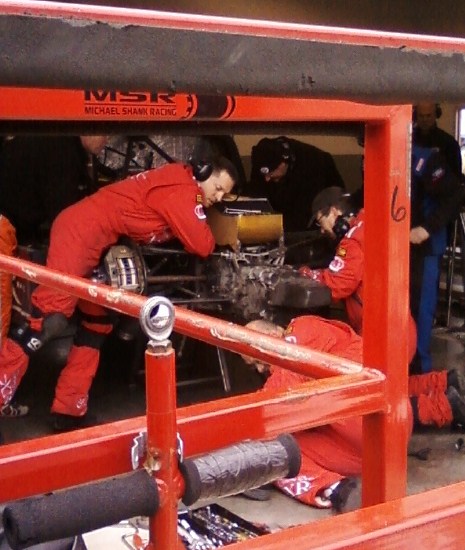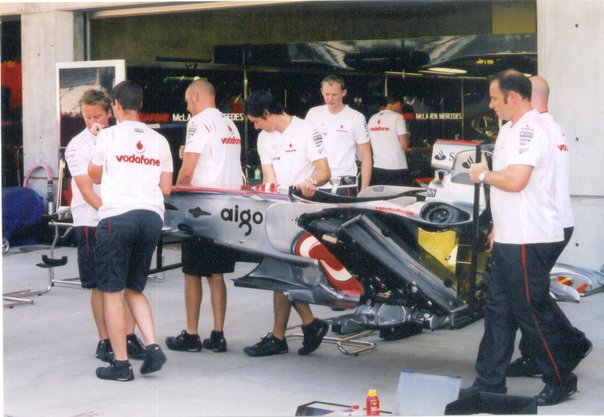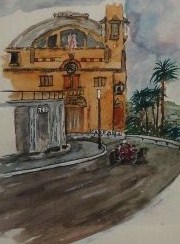What Happens When There is, Nearly Literally, No News
12:01am EST — Now that the excitement of the Chinese GP (and the subsequent portrayals of Around the World in 80 Days by the teams and F1 circus to get back home) is over, what seems like an interminable three week break until Barcelona is one third over. The teams are generally quiet, working on their updates for the beginning of the European season a bit later than usual with the break in air traffic, the drivers are relaxing and working out and doing whatever promotions necessary during the layover, commentators are floundering wildly for just about anything at all to talk about, and fans are waiting for news and a return to action.
Four races into the season, though, there is time for reflection and a re-evaluation of what we had thought might happen before the season began. Big story-lines before Bahrain included the return of Michael Schumacher (and his re-teaming with Ross Brawn at Mercedes), Fernando Alonso at Ferrari, intra-team squabbles, three new teams, and (depending on your calculations) six rookies. Oh, yes, and one boring race and three exciting ones, though that may have been down to weather conditions and not so much a return to extremely close racing. Bahrain was generally considered a snooze, despite it being the beginning of Vettel’s early-season bad luck and a Ferrari 1-2 (Bahrain Grand Prix Redux), Australia brought interesting race conditions and the beginning of Hamilton’s bad luck (or bad behavior?) while Button won his first of two races so far (Australia Grand Prix Redux), Malaysia’s weather made qualifying topsy-turvy as Vettel turned his disappointment into a win (Malaysian Grand Prix Redux), and China brought rain and many tire changes into play for McLaren’s turn at a 1-2 (Chinese Grand Prix Redux).
However, what many assumed would be the biggest story-lines at the beginning haven’t been quite as monstrous as anticipated. They’re still important and getting quite a bit of attention, but seem to be less a priority within the paddock. Schumacher has returned, but certainly not triumphantly (good or bad, you be the judge. honestly, go vote in the F1B Oversteer vs. Understeer about just that). He has been regularly out-qualified and out-paced by younger teammate Nico Rosberg (in every session barring one Friday practice), and in China he was almost an impediment the likes of Sebastian Buemi to Alonso, Massa, Hamilton, et al.
Fernando ALonso is at Ferrari, but the bigger story there, after much PR work by both the Spaniard and the team making it clear they like him and he likes them far more than Kimi Raikkonen in red or Alonso at McLaren, is the projected intra-team squabble between him and Massa. Both have given as good as they’ve gotten, and neither has made moves that punted the other off the track, though there has been some good dicing between them when it counted. In the other pre-season intra-team drama, Jenson Button and Lewis Hamilton don’t seem to be fighting so much with each other on the track as Hamilton seems unhappy with the team, his performance, or both. While Button has won two races, Hamilton has been cited for aggressive driving off the circuit, had two reprimands for aggressive driving on the track, and has taken out tire frustration on the team. It will be interesting to see how the two British world champions deal with the rest of the season in their British team, which is currently leading the constructors’ world championship.
The new teams have been experiencing the expected growing pains, but do seem to be adapting accordingly. In an unexpected twist, Sauber seems to have added itself to the new category with continual mechanical failures and an inability to finish races. In fact, much touted rookie Kamui Kobayashi has yet to finish a race in 2010, despite showing much promise for the final two races in 2009 (which makes me very sad, as I was all set to become a Kamui fangirl). In China, many of the new teams were actually running in the points for a while, while the tire strategies of the top drivers shook themselves out. It made for very interesting racing.
Finally, the rookies. There are a couple of drivers who can be classified as rookies despite their previous F1 starts: the aforementioned Kobayashi and Jaime Alguersuari, who only began his F1 career at the Hungaroring last season and has not completed a full F1 season. Vitaly Petrov seems to be the undisputed king of the true rookies, though, with points in China and a great battle with Hamilton in Malaysia. Three (Bruno Senna, Karun Chandhok, and Lucas di Grassi) of the true rookies are racing for new teams, making it more difficult to chart their progress, while Nico Hulkenberg has been struggling at Williams (though his greatly experienced teammate Rubens Barrichello has as well). Interestingly enough, Pedro de la Rosa and Michael Schumacher, neither of whom has raced for three years or more, are also struggling. However, de la Rosa is in the troubled Sauber while Schumacher’s Mercedes is at least capable of upper points paying positions.
All in all, it has been an exciting early season, both on and off the track. Still, that on-track excitement has been encouraged by adverse weather conditions and poor qualifying decisions by some of the teams. While there are many discussions on how to improve the show, 2010 has proven that the easiest way would be to simply install sprinklers at random locations on each track. When the race gets too processional, turn them on and let the strategy and precision driving ensue.
26 April, 2010
Categories: Formula1 . Tags: Adrian Sutil, Australia, bahrain, Barcelona, Bruno Senna, China, F1, Felipe Massa, Fernando Alonso, Ferrari, Force India, Formula1, Heikki Kovalainen, HRT, Jarno Trulli, Jenson Button, Kamui Kobayashi, Lewis Hamilton, Lotus, Lucas di Grassi, Malaysia, Mark Webber, McLaren, Mercedes, Michael Schumacher, motorsport, Nico Rosberg, Pedro de la Rosa, practice, qualifying, Red Bull, Renault, Robert Kubica, Ross Brawn, Sauber, Sebastian Vettel, Spain, Timo Glock, Tonio Liuzzi, Virgin Racing, Vitaly Petrov . Author: Victoria Reid . Comments: Leave a comment

 OASTD
OASTD



